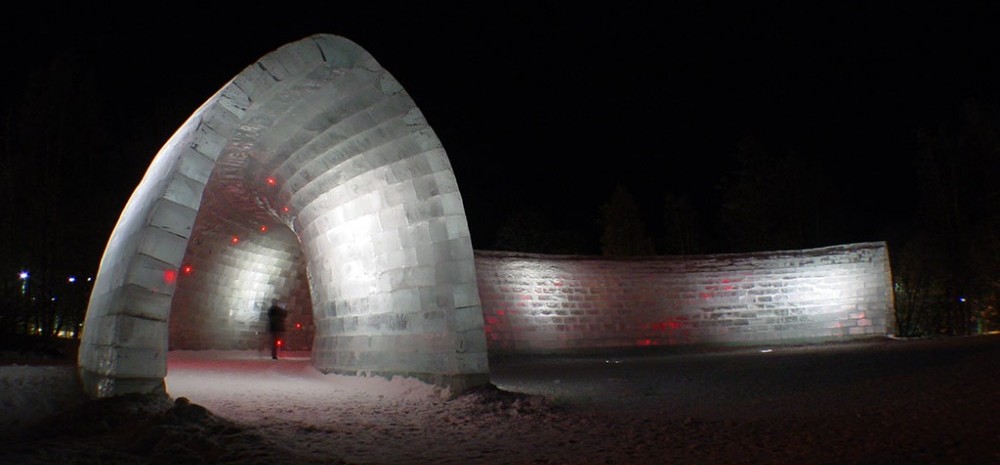Roveniemi and Kemi, Lapland, 2003 and 2004
A ritual is an action distinguished from all others in that it seeks the realization of it’s purpose through the exercise of form. In this sense ritual is art; and even historically, all art derives from ritual. -Maya Deren
Throughout human history, shelters and constructed environments have been key manifestations of civilization. The act of making places for ritual use is the earliest form of the human need for expression. Whether natural or manufactured, shelters were transformed into architecture through purposeful use and demarking them as special (and sometimes sacred) places. As time passed, inhabitants accentuated their dwellings through various forms of marking for story-telling purposes, which later evolved into a form of narrative decoration. On every continent human ritual has spawned acts of architecture and art. As society developed, human activity diverged and specialized. For art and architecture this created a rift between fields that share common roots. The condition in the twenty-first century shows our society is becoming increasingly complex-and hence problems can no longer be easily separated and resolved through a single discipline.
The Snow Show provides a unique opportunity to reexamine the ritual spirit, through the collaboration between the worlds of art and architecture. This method of working illustrates the interconnected origin, knowledge and the character of problem solving in these adjacent fields. The Snow Show will be a first-of-a-kind exhibition of artist/architect collaboration that is realized on a significant scale, consisting of thirty structures made of natural materials. A ritual is formed between paired artists and architects that will be manifested in snow and ice. By replacing materials that are both familiar and permanent with ones that are freshly unusual and ephemeral, the curators hope to neutralize initial fixity of ideas. This partnership of artists and architects in a unique setting will encourage a freeing flow of communication that allows an overlap in their individual interests and expertise. Practitioners of both disciplines will utilize their critical approaches to determine standards of quality, and illustrate their ability to work together in creating works that are both intellectually challenging and beautiful (as are the most successful works of public art or architecture).
The pivotal power of The Snow Show is that it’s a laboratory for the collaboration as a productive direction for the visual and practical arts. Since September 11th, the arts community has confronted the question: Where is the new art, and how do recent events affect the arts? The curators of The Snow Show respond with “collaboration†as an alternative to the typical (and romantically individualistic) view of the individual artist working away, isolated in his studio. “Global Art†has been championed as the “new art formâ€, yet as a concept it often falls short to our expectations. Global Art is so “global†that art from around the world can begin to look the same. Cultural and personal distinctiveness are what should make art worthwhile. The intensely collaborative discourse developed within The Snow Show questions the fabric of creative thought and the way our society approaches its problems. This discourse is formed through the pairing of individuals whose work and outlooks are clearly disparate, and having them focus on a problem that neither can dominate. What happens when creative minds have to be focused on a single problem in a symbiotic effort? How much do they discover about how the two fields overlap? Is this overlap due to individual personal chemistries, or is there a general pattern? Will the artist examine the task at hand from an architectural point of view and the architect as an artist would? Can a set-up collaboration foster communication or is the structure too artificial? These and many additional questions arise through The Snow Show. Research gained from The Snow Show will conclude in an international museum exhibition. This exhibit will place in a curatorial and academic context the professional, theoretical, and philosophical aspects of collaboration between art and architecture. The traveling exhibition will examine the work of the artist/architect teams through photographs, drawings, videos, models, and other materials.
Through the inspiring approach of collaboration, the curators hope to use The Snow Show as an example to prove that, in some cases, working as a team may yield greater (or more interesting) fruit than working alone. The collaborative premise will be the driving force throughout the design of the exhibition and the surrounding events: The Finland cities of Rovaniemi and Kemi in Lapland are collaborating with each other to bring about this major event. At the political level, education, labor, and culture will collaborate to create an international, multi-faceted event. Finally, the greatest collaboration of all will take place when the international participants and visitors converge and co-mingle at the Lapland site. The culmination of the process will be a festive opening where we expect both international and national press to attend-and through which the rest of the world can experience the spirit and excitement of The Snow Show.
Lance Fung
Chief Curator of The Snow Show 2002
